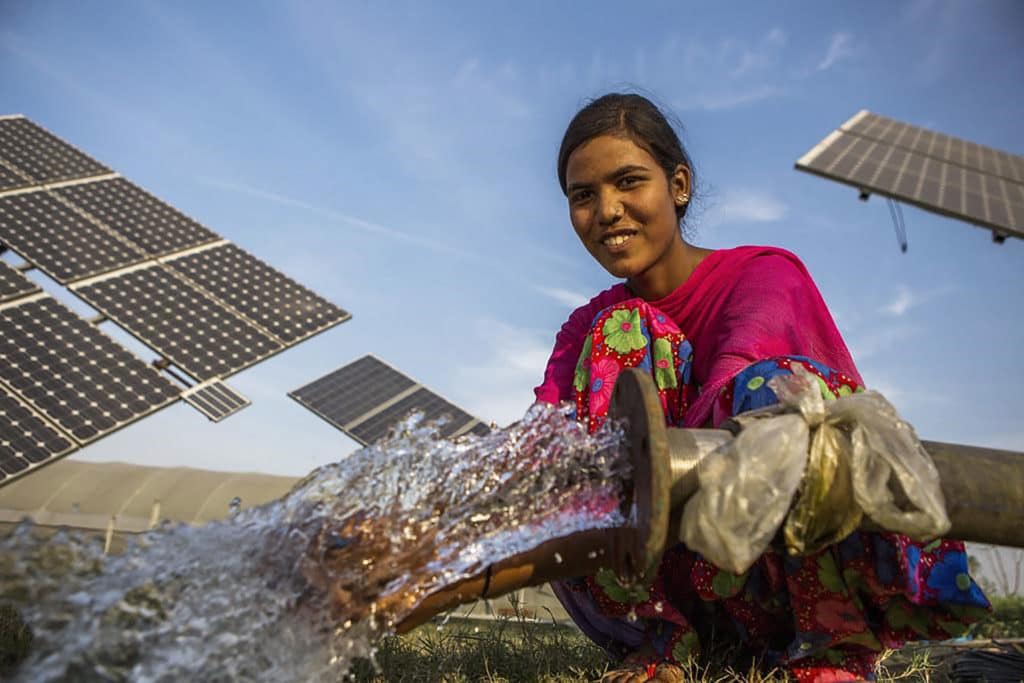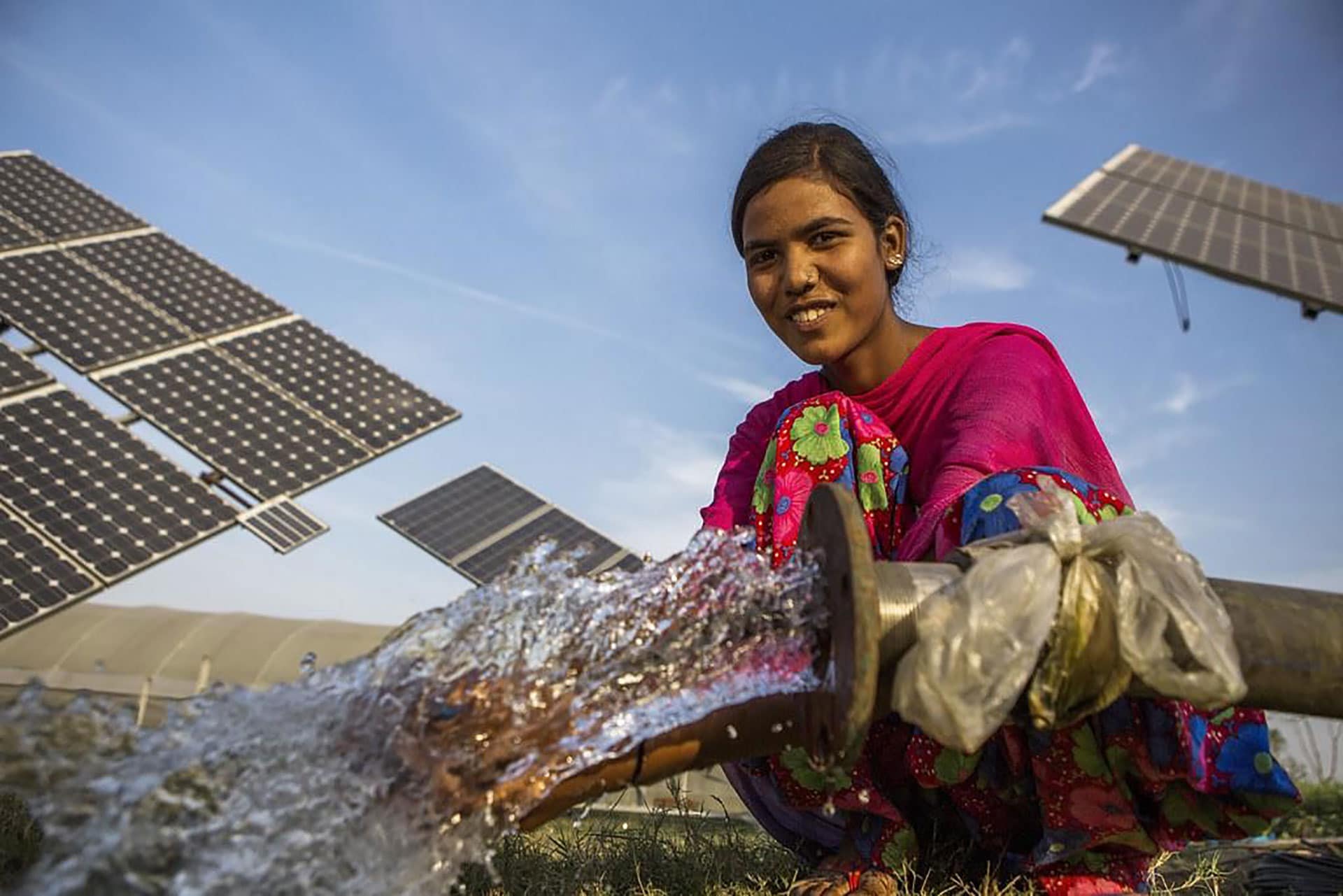As recently as 2015 one basic solar-powered water pump could cost $1,500. Futurepump says it can sell you one in Nigeria today for a little over $500.
In a small factory in Rajkot, Gujarat, India a company called Futurepump manufactures a series of small modular devices designed for and marketed to smallholder farmers. The company says their machines are lightweight, easy to use, easy to fix, and–best of all—free to operate as they’re fueled entirely by sunlight. “Zero fuel costs. Earn more Money. Grow all year,” as the company puts it in a marketing brochure. “Futurepump solar water pumps let you irrigate with the power of free sunshine.”
Futurepump is an international operation—their portable solar-powered water pumps are manufactured in India, tested in Nepal, and distributed to customers in South Asia, Africa, and South America, with employees scattered in its marketing territories, the United Kingdom, and the Netherlands. Futurepump says its devices are designed to operate on farms of only about one hectare in size, and they make bold claims about the benefits of using one on their website. But can small, affordable solar-powered water pumps make a substantial difference in smallholder farmers\’ lives, as the company claims? We don’t have to take Futurepump’s word for it; major international aid agencies, the World Bank, and the Institute for Energy Economics and Financial Analysis (IEEFA) all currently tout the promise of solar water pumps in smallholder agriculture. But as with most potential breakthroughs, the devil is in the details.
Futurepump’s products seem elegant in their simplicity. The company’s photographs show small rotational pump devices boxed in and protected by an open metal frame for easy portability. Wiring connects the pump to its power supply: a small single solar panel or a two-panel foldable array for larger pumps. A simple hose carries water from one end and delivers it to another. The products come with a 10-year warranty, spare parts, and potentially field support if a customer\’s farm is located near one of the company\’s offices. Units range in power outputs from 60 watts to 120 watts and can pump water at a rate of 0.5 to 1 liter per second. The company even shows how to set them up in YouTube videos.
Though these machines may seem simple, researchers see solar water pumps like these potentially leading “a major disruption in the global farmer-led smallholder irrigation scene,” according to a 2020 World Bank study on renewable energy in developing-world farm irrigation. The Bank study calls these machines solar irrigation pumps or SIPs for short. Development agencies have been testing and tinkering with them for decades, but the World Bank’s review argues that solar irrigation pumps’ moment in the sun in sub-Saharan Africa has finally arrived. “They are high on capital cost, but once installed, they operate at a near-zero operating cost, which is a great advantage for smallholders for whom the high overall cost of fetching and using diesel or petrol often poses a big barrier,” the study says.
In a separate analysis published this summer IEEFA advocates for the large-scale deployment of smallholder solar irrigation systems to India’s farms. Such an initiative, the group argues, would help India meet its solar power capacity targets, fight global warming, and benefit smallholder farmers who command a major portion of Indian agriculture. These machines could also help wean farmers away from expensive state-subsidized power that drains government coffers while failing to encourage more efficient downstream water consumption at India’s farms. “In IEEFA’s view, solar irrigation pumps, when implemented sustainably, are a key instrument to tackle the growing challenges of the nexus between food, water, and energy in India,” writes research analyst Kashish Shah.
Simple, easy to use, and potentially game-changing–but there are further details to address before smallholder solar irrigation can ever truly become mainstream.
First, as the World Bank study alludes to, the devices are still fairly expensive, though costs have been falling sharply in tandem with steeply falling solar photovoltaic technology prices. As recently as 2015 one basic solar-powered water pump could cost $1,500.

Futurepump says it can sell you one in Nigeria today for a little over $500. A much-improved price point, but still high in relation to farm incomes in Nigeria. Most smallholder farmers in sub-Saharan Africa probably still can’t afford to purchase a solar irrigation pump without financing. And unfortunately, as World Bank, African Development Bank, and International Water Management Institute researchers explain in a new study published in the Journal of Development Studies, government-funded irrigation support projects tend to focus on lands best suited for irrigation, to improve their chances of success. However, farmers with access to such land tend to already have higher incomes than those where irrigation is deemed technically or economically infeasible. (https://doi.org/10.1080/00220388.2021.1939866).
The biggest issue may be simple water access—there\’s little point in deploying a solar irrigation pump device if a farm has no water to pump. Though experts agree that solar irrigation pumps can be enormously beneficial to smallholder farms, they are meant to be used where farmers already enjoy access to either a shallow water well or a nearby surface water source like a lake, stream, or river. If a well is too deep, the pumps won’t work. But as the price of solar panels continues to decline, they could be useful to an increasing number of farmers, especially where government programs support financing and maintenance.
Often, agriculture changes slowly. But sometimes, the cost of equipment falls almost as quickly as solar panels or computer chips and inspires us at Grow Further.
— Grow Further
Photo credit: A solar-powered irrigation system at a farm in India. International Water Management Institute, Creative Commons.




